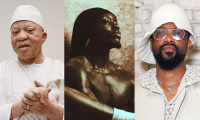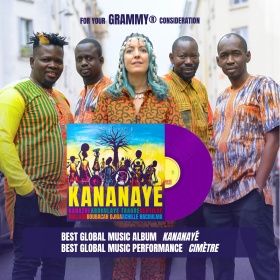5 music videos 'banned' in East Africa
When Tanzanian artists AY and Diamond Platinumz released a re-mix of the song ‘Zigo’ at the beginning of this year, the Tanzania Communications Regulatory Authority (TCRA) quickly banned it from the country's mainstream media for being too raunchy.
 A scene from Tanzanian artists AY and Diamond's popular but controversial video for ‘Zigo’.
A scene from Tanzanian artists AY and Diamond's popular but controversial video for ‘Zigo’.
But if the authorities thought ‘Zigo’ was raunchy, they could not have been prepared for what followed a few months later, when a female Tanzanian artist, Snura Mushi, released ‘Chura Dance' with another controversial video. Clearly it was just the tip of the iceberg - and of course Tanzania is not the only East African country that has seen music videos being restricted or banned. In nearby Kenya, Rwanda and Uganda, musicians and video producers have also found themselves clashing with authorities over how far they can push the notion of freedom of expression in their videos.
Across the East African region, critics have long felt that authorities tend to use double standards when it comes to the censorship of works of art. While international content enjoys undisrupted broadcasting, authorities tend to only act on local content, and when certain members of the public express their discomfort. For example, in February 2016, when Kenyan rapper Noti Flow teamed up with Art Attack to release ‘Same Love’, a song and video promoting tolerance for homosexual relationships, the Kenya Film Classification Board (KFCB) could not hide its dismay and not only banned the video but went as far as asking Google to pull it from YouTube, although this of course was not to be.
Authorities such as the KFCB have on various occasions found themselves at the receiving end of criticism from the public, many of whom disapprove of these bodies acting as ‘moral police’ and attempt to dictate what is fit (or not fit) for public consumption. One Kenyan commentator, for example, recently weighted in on the decision by the KFCB to censor Coca-Cola adverts, writing: "Your work is not to regulate immorality. You need to relook at the law and your mandate so that you can develop this country, not stifle talent, information, entertainment and education and information."
In 2014 Uganda passed its strict Anti-Pornography Act. In Kenya meanwhile, following the banning of the Coca-Cola adverts, the KFCB has asked all media houses to comply with its Programming Code as from 1 July 2016. The code expects all TV and radio programmes to adhere to its basic principles, with any breach resulting in serious penalties, including revoking broadcast licenses.
Despite these measures, East African artists have not been shy to push the limits. Here we feature five popular music videos that have in recent years been deemed offensive by authorities. Ironically, official attempts to censor or ban them from public broadcasters have simply helped to promote curiosity and drive up views on online platforms such as Youtube.
1. Sauti Sol - ‘Nishike’ (Kenya)
YouTube views: 1.8 million+
In 2014 Kenyan pop group Sauti Sol set the interwebs ablaze when they released the video for ‘Nishike' (Touch Me). While it was rated ‘too hot’ for Kenyan TV stations, many could not get enough of it and YouTube offered them the chance to watch the video over and over. For moralists the video was seen to objectify women. Despite the steamy scenes that got many hot under the collar, the creativity of the production team was of great quality. The story revolves around a man taking his lover on a fantasy ride. Expertly directed by young Enos Olik, the song's video was nominated for East Africa’s Best Music Video at the Channel O Music Video Awards and was arguably Kenya’s most watched music video of 2014.
2. Panadol wa Basajja - ‘Ensolo Yange’ (Uganda)
YouTube views: 38 000+
Jemimah Kansiime, the Ugandan female artist also known by her stage name Panadol wa Basajja, was charged under the country’s strict anti-pornography laws after appearing scantily-clad in her video for ‘Ensolo Yange’. Uganda’s Ethics Minister Simon Lokodo described the video as “very obscene and vulgar” and threatened to send the artist to jail for 10 years. The censorship and its subsequent contestation raised questions worldwide on whether there should be some space allowed for so-called 'erotic' entertainment and encouraged debate over where exactly these limits should be drawn.
3. AY ft. Diamond Platnumz - ‘Zigo’ (Tanzania)
YouTube views: 6.4 million+
Within two months of release, the remix of ‘Zigo’ had garnered over 2.9 million views. A few months down the line, the video's popularity has shown no signs of waning, with Youtube hits passing the six million mark, despite (or perhaps largely because) the Tanzania Communications Regulatory Authority (TCRA) banned ‘Zigo’ from all TV and radio stations in Tanzania. AY has put the TCRA to task, demanding an explanation as to just why ‘Zigo’ was banned.
4. Snura - ‘Chura Dance’ (Tanzania)
YouTube views: 795 000+
Tanzanian female artist Snura Mushi recently released ‘Chura Dance' with another controversial video, which features women twerking frantically on the beach. It was a hit among fans, with the video going viral on YouTube soon after its release. The powers that be were shocked at the video, however, and not only banned it but also barred the artist from performing the song in public, clearly fearing the prospect of widespread public displays of twerking. The artist was asked to pull down the video from YouTube until she could 'amend' the song and video, but really, why would she?
5. Urban Boyz - ‘Ancilla’ (Rwanda)
YouTube views: 98 000+
When Rwanda's Urban Boyz released the video to their ‘Ancilla’ track in 2014, there were mixed reactions over whether the trio had gone overboard - or what many people termed as ‘too much Westernization’. The country's Ministry of Sports and Culture decided to ban the song from public viewership after holding extended talks with the band. The two parties apparently reached some degree of “mutual consent”, with the trio reluctantly agreeing that the song would no longer be aired in public - although of course viewers keep watching online, ensuring that the video is now nearing the 100 000 mark on YouTube.
























Commentaires